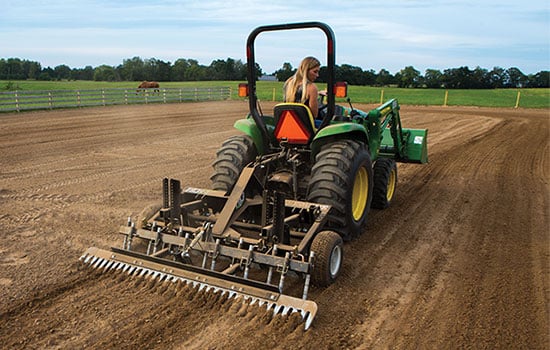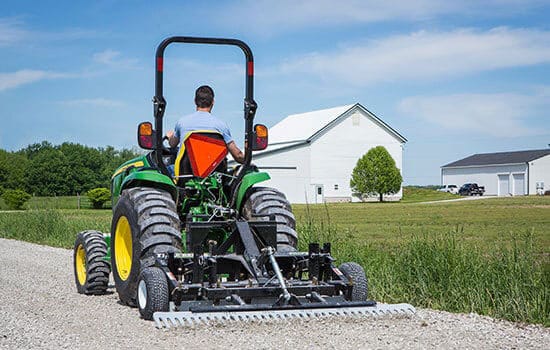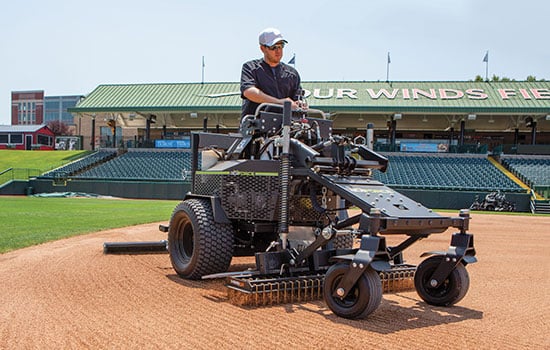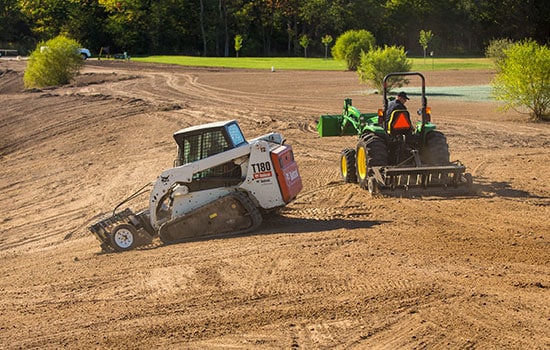TR3 Rake – John Lyons Arena Drag
Transcript
Well, I’m John Lyons, I can tell you a little bit of my experience with the TR3. First of all, if the if the ground is perfect, if we have absolutely perfect ground, it really doesn’t take a great piece of equipment, you know, to work that ground to get it rideable. I think most of us don’t have perfect ground every place that we ride or in in our arena. And so what I look for is a piece of equipment that will do several different things.
Number one is that it will last. In other words, if I work the ground, that I don’t have to repair the equipment after I work the ground.
Two is, it will actually work the ground. I can’t give you a better demonstration than what we had in our arena here last night. It had rain. There are a bunch of dirt clods in this ground just turned to rock. And I mean, this the ground is so amazingly hard. Now, I’ve got several different types of pieces of equipment. I’ve used rototiller like a garden rototiller, heavy duty rototiller. We’ve used that on this ground. And it works. But the problem is it takes about nine hours, eight to nine hours to do this three acre arena. And then at the end of that, I have to repair the rototiller because it wears out the teeth in the rototiller actually. And it will start out two and a half inch blades and it’ll go down to about a half inch blade, which is about a three hundred fifty dollar bill. So when that ground gets that hard, I’ve just not found any piece of equipment other than the TR3, which I can actually show you how that actually worked. I mean, we I spent about two hours last night on this arena and we’re it was absolutely not rideable at all. It is now rideable. And people were using it last night and they’re riding doing a clinic in it today.
So the TR3 I just can’t say enough about it as far as doing a great job on a normal arena. But if you’re like me, if you have places that are not normal, an arena that is not the perfectly manicured arena, and yet you need to make it rideable TR3 is outstanding even from from last night. Zero wear on on the piece of equipment, zero damage. Zero wear. And that’s such a huge thing because once I use the equipment, if I have to stop and fix it or repair it or I see a lot of wear, then then a piece of equipment is just going to wear out sooner. So, I mean, I absolutely love this thing.
Now, I don’t use it just on the arena. There’s we have Jody Anahad. I have about sixty five acres here and we’re doing lots of projects, lots of improving projects from down at the river. We’re working on clearing land. And and once I am, I clear all the land off with the bulldozer. Then I come back with a TR3 and smoothed it out and I’ll show you that area. I use it on open fields where I’m trying to get it actually get the ground ready to plant plant grass on. So I use it for that. I’ve used it on developing some trail areas. It’s just great for that because once I get the brush out of the way and I and I bring it, I bring the TR3 through it once or twice, then it really clears it off and it makes it level and really makes it nice. So I don’t use my TR3 like a lot of trainers and that would be in a perfectly manicured arena where the ground is perfect and everything everything is hunky dory. I use the heck out of this thing and and I abuse it, you know, to some extent. And I’ve just had I just can’t tell you enough of how much I respect this piece of equipment and how well it works. It’s just a terrific piece of equipment. And I would recommend it to anybody for any kind of arena. Or do you if you’ve got the perfect place. Congratulations. It’ll do perfect for you. If you don’t have the perfect place and you don’t have the perfect soil and you don’t have the perfect ground. It will do outstanding for you. It is a great, great piece of equipment. So I’m glad and tickled to recommend it to anybody. Why is footing important? And like last night, if we would have tried to ride on this arena the way it was, what would have happened? Well, physically, we absolutely could not. You’d cripple a horse within within a few minutes.
The dirt clods were actually like softball size and bigger rock. So it’d be like riding your horse over that continually and trying to him, etc. You’ll end up, you know. Tripling your horse or making them go lame. Stone bruises, all that kind of stuff. Grounds important. We were all trail rider, horse and obviously the ground’s not perfect for trail riding. But then again, we’re not doing a lot of loping, a lot of lead changes. A huge amount of stress over areas like if you’re going down a creek bed or something. I mean, you’re taking it pretty easy. You’re not you’re not jamming your horse through that. You’re also in that if you’re crossing a creek bed or on a trail and the ground’s not good, again, it’s not something you’re you’re loping on. It’s not something that you’re riden and trying to develop performance horse on where you’re you’re really working his legs hard. So ground is critical when you’re trying to keep a horse sound. Ground is critical when you’re trying to train the horse because you don’t necessarily for performance. You don’t want that horse worried about if he’s going to step in a pothole, if he’s going to step in and it’s going to hurt when he steps or if you’re trying to teach him to stop and you ask him to stop and he stops and he hurts his hurts his legs. In other words, if the ground skin’s him or or he hits a rock and it bumps the back of the back part of his legs, then the next time he’s not going to try to stop so hard. So ground is important for keeping your horse sound.
Ground is important for developing a really, really nice performance. Horse ground is important for a young horse while you’re training him so he can focus on the training and not on worried about whether he’s going to step on something that’s going to hurt him, step in a hole, etc.
Why is ground now so important is because we’re riding these horses younger, we’re riding them harder when we’re riding them there. We’re putting them through more stress in the training and we find out that we don’t have to deal with nearly as many leg problems. There are lots of bone tendons, you know, five years ago, ten years ago, fifteen years ago. And now it’s just an accepted part of the training. And and you hoped you would get through it and not have a bowed tendon not have a damaged leg or a crippled horse. But what we have found is there’s a lot of things we can do to save, let’s say, 50 or 75 percent of the horses that went unsound 10 years ago by paying a lot more attention to the ground and what our horses traveling over. So the recent concern is really the concern was always there. It’s the education and the opportunities weren’t there to really learn how to improve this ground and make it better for us.
As a horse owner and a trainer. What’s really good with with certain companies, as you see companies giving back to the horse owners, it isn’t that they’re just selling a product, but they’re also and that’s what their job is, is to sell that product and make the income off that product. But what’s great about some of the companies in the in the industry today is they’re giving back to the industry. Absolute Innovations is doing something to give back to the horse community. You’ll find out not only will you find out about horse arenas and dirt and that kind of stuff, but you can find out about training. You can find out about all kinds of different things. It isn’t that they’re just trying to sell you a product is they’re going to give back so much more. They’re going to have top trainers on that on their Web site where you can actually have chats with with those top trainers. There’s going to be just all kinds of different rooms, areas that you can go into that this company is giving back. Check out the Web site. Should see what all they have for the horse owners.



